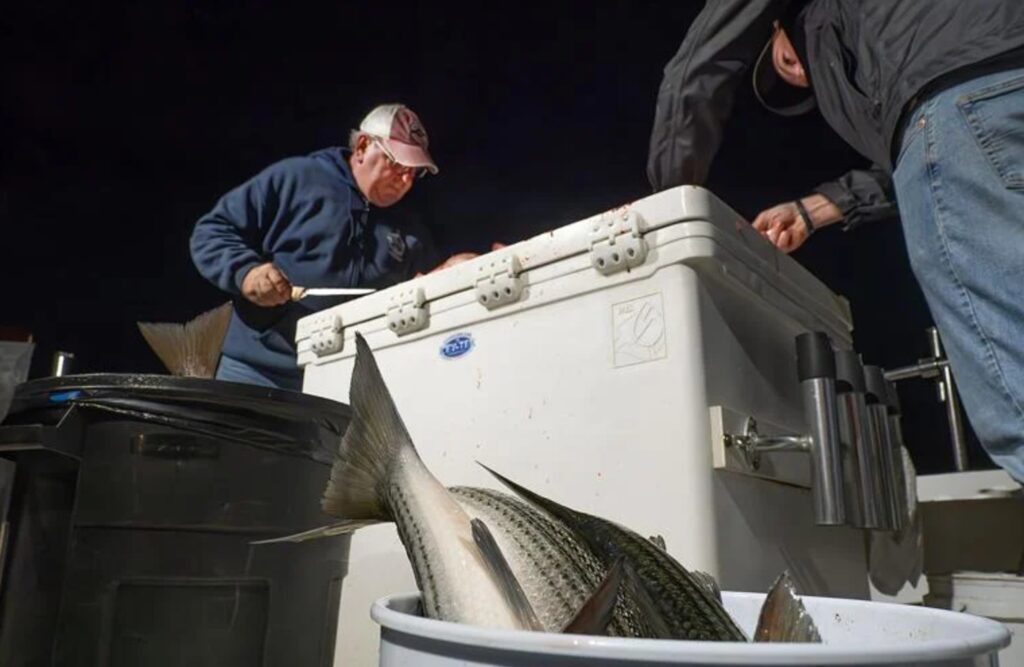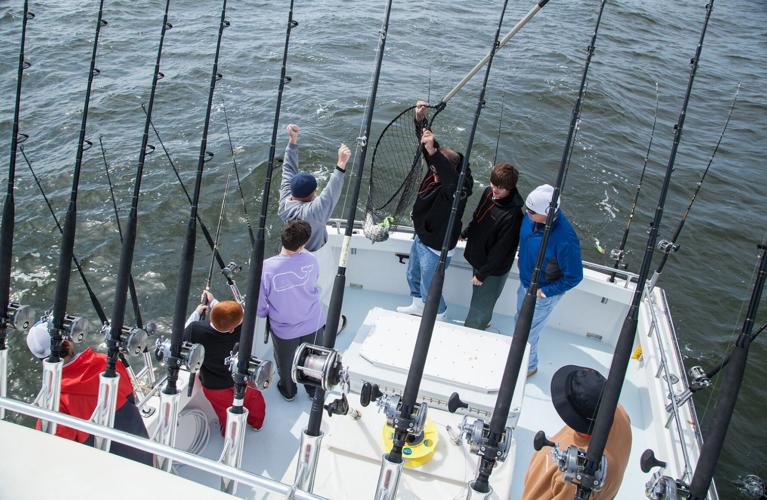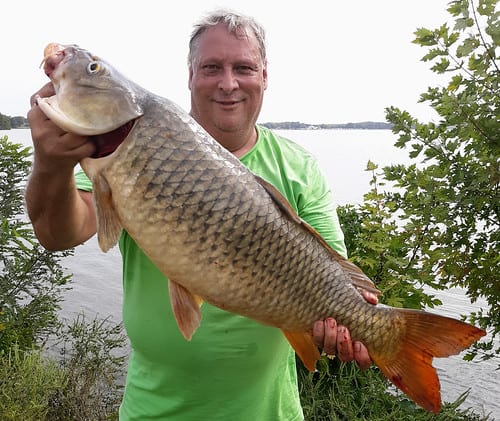It’s going to be a lean year for those who like to catch or eat Atlantic striped bass—with still leaner times perhaps to come.
The Atlantic States Marine Fisheries Commission, which regulates inshore fishing for migratory species, has ordered new curbs, starting May 1, on both recreational and commercial catches of the popular finfish, also known as rockfish in the Chesapeake Bay region.
Amid persistent signs of trouble with the species, the commission’s striped bass management board decided Jan. 24 to limit all anglers in the Chesapeake and its tributaries to landing one striper a day, and only if it’s between 19 inches and 24 inches long. Ocean anglers likewise can keep just one fish a day, but with a narrower legal-size window of 28 to 31 inches.
Maryland and Virginia watermen, meanwhile, face a 7% reduction in their allowed commercial harvest of the fish.
The board ordered those curbs with the hope of restoring the species’ abundance after a worrisome decline in recent years. Whether this will be enough for the struggling species to rebound is a toss-up. Equally uncertain is how many people who now earn a living pursuing them will be able to do so in years to come.
One of the most sought-after commercial and sport fish in the Bay and along the coast, striped bass range the Atlantic from Canada to the Carolinas. The Chesapeake serves as the primary spawning and nursery ground for 70–90% of the coastwide population. For five straight years, they’ve suffered from poor reproduction in Maryland’s portion of the Bay and its tributaries, with below-par spawning reported last year in Virginia.
The commission had already tightened catch limits after scientists warned in 2019 that striped bass were being overfished and that the number of adult female fish had fallen below what is needed to sustain the population. Scientists noted then that the widespread practice of catch-and-release fishing was killing a significant number of striped bass, especially in summer when warm water temperatures and lower oxygen levels further stress fish that are caught and handled.
After cutting recreational catches to one fish a day virtually everywhere, East Coast fishery managers thought that would be enough to eventually restore the population. They were jolted last year when surveys indicated the estimated recreational catch had nearly doubled in 2022.
In response, the commission took emergency action in May 2023, imposing a 31-inch maximum size limit on all recreationally caught fish. That was an interim measure to protect fish spawned in 2015, the last year of abundant reproduction. But managers agreed then that more curbs likely would be needed to help the fish back reach a sustainable level by the legally mandated deadline of 2029.
Few decisions by the Atlantic states commission have generated as much public debate. Nearly 700 people spoke at 15 hearings in 13 states in November and December; the commission also received more than 2,800 written comments.
The new recreational catch size “slots” were chosen with the hope of conserving two groups of fish: those not yet old enough to spawn and larger ones that are prolific spawners.
The board’s scientific advisors project that the new size restrictions will reduce the overall recreational catch of striped bass by 14.5%. For Maryland’s charter fishing industry, though, the cutback will be more severe because until now their customers have been allowed to keep two fish a day.

Mike Luisi, a commission member and fisheries manager with the Maryland Department of Natural Resources, warned that cutting the state’s charter boat clients’ catch to one fish a day “will put people out of business.” He tried, without success, to persuade the board to soften the economic impact on the for-hire fleet.
Others, though, insisted on a uniform one-fish daily limit in the Bay and coastwide.
“The dark days are coming,” warned David Sikorski, a commission member and executive director of the Coastal Conservation Association of Maryland. “It’s time to buck up [and] reduce fishing mortality.”
The striped bass management board also struggled over what do about the commercial harvest.
Some members, heeding appeals from recreational anglers, wanted to cut the fishing industry’s catch quota by 14%, roughly on par with the recreational reductions. But others argued the industry shouldn’t pay for the excesses of recreational anglers along the Atlantic coast, who had been mainly responsible for the big increase in estimated fishing mortality. More than half of the 2022 recreational catch came from New Jersey and New York, the commission said, with just 20% from the Bay.
“The problem is not with the commercial fishery,” argued Robert T. Brown Sr., president of the Maryland Watermen’s Association. Commercial fishing is tightly regulated, he pointed out, with each fish caught, tagged and accounted for, and the catch quota already reduced in previous years. In the Chesapeake, commercial harvest accounts for just over one-third of the total catch.
In the end, the board compromised on a 7% reduction in harvest quota. But in ordering that the cut take effect May 1, the board made it difficult if not impossible for Maryland and Virginia to comply. The 2024 commercial fishing season for striped bass is already underway in both states.
Brian Hardman, head of Maryland’s charter boat association, said he expects at least some of the state’s 377 for-hire fishing businesses to founder. He said many clients won’t be interested in going out for just one fish, and some repeat customers have already called to cancel bookings for this year.
“If we had a whole host of other fish to fish on, we would have other options,” he said. But with business already down from what it had been before the pandemic, Hardman predicted bookings would decline another 35–50%. “How long can we sustain that?” he asked.
The Maryland charter fleet reported catching 101,000 striped bass in 2022, according to state data. That’s a tiny fraction of the total recreational catch of around 3.4 million fish in the Bay and coastwide that year, according to estimates drawn from voluntary angler surveys.
“We’re the smallest user group and catch the least amount of fish,” Hardman said. “You can’t solve any problems on our backs.”
Meanwhile, Maryland is imposing additional striped bass fishing restrictions beyond what the Atlantic states commission has ordered.
A joint legislative committee in February approved emergency regulations that lengthen the time in spring when recreational fishing for striped bass is prohibited in Maryland’s portion of the Bay and its tributaries. “Targeting” of striped bass, which includes catch-and-release, will be banned from April 1 through May 15.
Fishing for striped bass was already prohibited in April, but the new rules extend the closure by two weeks. That eliminates the state’s “trophy” striped bass season—the first two weeks of May, when recreational and charter anglers had been able to keep one fish a day 35 inches or longer.
The rules also extend an existing early-season ban on fishing for striped bass in the Susquehanna Flats, prime fish habitat, until the end of May.
“We wanted to give striped bass as much chance as possible not to be interacted with [in April and May] to complete their spawning activity,” he said.
Hardman, the charter captain, countered that DNR’s proposal didn’t go far enough. If the state really wants to promote successful spawning, he said, then it should stop allowing recreational catch-and-release fishing even earlier—during the first three months of the year, when there’s evidence the big fish are entering the Bay to spawn earlier than in the past. “You’re going to put a Band-Aid on May and act like you’re doing something. It’s ridiculous,” he said. “If you want to protect them, protect them. Close it down.”
DNR has said it intends to propose further regulations later this year, including a one-week extension of the summertime closure of striped bass fishing. That would run from mid-July through the first week of August, when hot temperatures weaken fish and increase the likelihood that catch-and-release would kill them. Luisi said DNR might consider including a March closure in those proposed rules.
You can read this article in full at bayjournal.com.




